 Your new post is loading...
 Your new post is loading...

|
Scooped by
iBB
January 31, 2023 1:45 PM
|
Exploring the Potential Molecular Mechanisms of Interactions between a Probiotic Consortium and Its Coral Host
A new article provides a genome-based roadmap to facilitate the selection of coral probiotics, also known as Beneficial Microbes for Corals (BMCs), and was just published in mSystems. Probiotics are starting to be investigated as a potential medicine for corals, marine animals that are threatened with extinction by the advance of climate change. Laboratory experiments have already proved the concept that coral probiotics mitigate coral bleaching and reduce coral mortality. This study now employed comparative genomics to identify exclusive BMC traits associated with specific probiotic strains and proposed new BMC mechanisms. The work was led by Prof Raquel Peixoto and her team from KAUST University at the Red Sea and received guidance on genomics of coral-associated bacteria from iBB/DBE researcher Dr Tina Keller-Costa.

|
Scooped by
iBB
November 11, 2022 5:21 AM
|
The newest release of YEASTRACT+ offers modeling tools to optimize yeast cell factories and identify new antifungal drug targets
The YEASTRACT+ information system is a wide-scope computational tool for the analysis and prediction of transcription regulatory associations at the gene and genomic levels in 11 yeast species of biotechnological or human health relevance. Its newest release, orchestrated by a large team led by Isabel Sá-Correia, Miguel Teixeira, from iBB, and Pedro Monteiro, from INESC-ID, has just described in the 2023 Nucleic Acids Research Database Issue, highlighting the availability of new regulatory-metabolic network modeling tools. These tools are expected to contribute to guide YEASTRACT+ users in the optimization of yeast cell factories of industrial relevance and the identification of new antifungal drug targets, to be used in advanced antifungal therapy. YEASTRACT+ is currently supported within the context of the Biodata.pt/Elixir.pt Research Infrastructure.

|
Scooped by
iBB
July 29, 2022 11:19 AM
|
Microbiome manipulation for improved host and ecosystem health
In a perspective article published in Nature Microbiology, experts in the field of symbiosis and microbiome research address the current, acute loss of plant and animal diversity that poses serious threats to the functioning of terrestrial and marine ecosystems, human health, and the development of a sustainable bio-based economy. The potential, and examples of success, of microbiome-based interventions such as probiotics administration and microbiome transplants in improving the health and resilience of a broad range of host organisms towards climate change stressors and the emergence of novel diseases is debated, and a perspective is provided on how such interventions may contribute to the conservation and maintenance of services of man-made and natural ecosystems. The perspective, led by Prof. Raquel Peixoto at King Abdullah University of Science and Technology (KAUST), counted on expert contributions by iBB-BSRG researchers Dr. Rodrigo Costa and Dr. Tina Keller-Costa on microbiome manipulation strategies in aquaculture and coral reef ecosystems. The initiative was launched by a round table headed by the Beneficial Microorganisms for Marine Organisms (BMMO) network during the 15th Symposium on Bacterial Genetics and Ecology (BAGECO15, Lisbon 2019) chaired by Prof. Rodrigo Costa.

|
Scooped by
iBB
July 21, 2022 4:44 AM
|
Vibriosis Outbreaks in Aquaculture: Fundamental and Public Health Concerns
Bacterial pathogens belonging to the Vibrio genus such as Vibrio parahaemolyticus, Vibrio alginolyticus and Vibrio vulnificus are some of the most common and widespread disease-causing agents in the aquaculture industry, inducing severe losses in fish and shellfish production worldwide. In a Review Article published in Frontiers in Microbiology, iBB researchers Gracinda Sanches Fernandes, Isabel-Sá Correia and Rodrigo Costa performed a meta-analysis of vibriosis outbreaks reported for the economically valuable, model aquaculture fish gilthead seabream (Sparus aurata) in the Mediterranean zone. The study reveals the acquisition of multiple antibiotic resistance traits among pathogenic Vibrio species during the past 25 years. An increase in human infections caused by Vibrio pathogens of fish – either via seafood ingestion or wound colonization - has been documented in the recent literature, and it is believed to result from the synergistic interaction between the expansion of intensive fish farming across coastal ecosystems and global warming. Finally, the authors critically examine the potential, and review cases of success, of alternative methods to antibiotics use to suppress vibrio pathogens in aquaculture, including vaccines, phage therapy and probiotics supplementation. Diverse bacterial symbionts of fish suppress vibrio pathogens in experimental trials, suggesting that the natural fish microbiome may be a reservoir of biological control agents of interest in applied biotechnology.

|
Scooped by
iBB
June 29, 2022 6:24 AM
|
Antimicrobial Activities and Metabolomes of Aquimarina from the Rare Marine Biosphere
The marine bacterial genus Aquimarina is a promising source of novel natural products. A new study published in Marine Drugs demonstrated widespread ability of Aquimarina species to inhibit growth of human-pathogenic microbes such as Candida glabrata and methicillin-resistant Staphylococcus aureus, as well as Vibrio and other marine bacteria relevant to aquaculture. Metabolomics and genomics analyses of Aquimarina strains indicated the presence of novel polyketides and peptides, including cyclic depsipeptide-related compounds. The study further showed that Aquimarina species possess low-abundance distributions across marine biotopes worldwide. It emphasizes the relevance of this member of the microbial rare biosphere as a promising source of novel natural products, supporting future efforts to isolate new bioactive compounds from Aquimarina. The work was developed within the SymbioReactor project (DGPM | Fundo Azul program) led by Prof Rodrigo Costa and Dr Tina Keller-Costa and was first-authored by PhD student Sandra Silva. It also includes former MSc student Patrícia Paula, Dr Dalila Mil-Homens, Prof Miguel Teixeira and Prof Arsénio Fialho from BSRG-iBB as coauthors.

|
Scooped by
iBB
June 5, 2022 11:33 AM
|
Sea Ice Prokaryotic Communities in the Subarctic
A transatlantic endeavour involving researchers from BSRG-iBB, CQE (IST) and Université Laval and INRS (Canada) provided the first comprehensive assessment of prokaryotic communities in the late winter ice and its underlying water along a natural salinity gradient in Hudson Bay, a cryo-environment marking the transition between Subarctic and Arctic biomes. The study, published in Science of Total Environment, was led by Prof. Rodrigo Costa, first-authored by MIT-Portugal PhD student Lígia Coelho and co-authored by PhD student Joana Couceiro, Dr Tina Keller-Costa and Profs. Zita Martins and João Canário. The team found sharp shifts in community structure between the ice and underlying water samples at sampling sites with higher salinity, and high abundance of culturable, pigment-producing bacteria in ice. The study suggests that salinity, photosynthesis and dissolved organic matter are main drivers of prokaryotic community structure in the winter ice of Hudson Bay, the ecosystem with the fastest sea ice loss in the Canadian North.

|
Scooped by
iBB
April 27, 2022 5:13 AM
|
Modeling the Full Metabolism of the Human Pathogen Candida parapsilosis
Understanding the behavior of human pathogens is both a challenge and a need, if we are to address infectious diseases with the best possible tools. Genome-scale metabolic models are a way to meet this task, which was just used for the second most prevalent Candida species in Europe, Candida parapsilosis. The construction and validation of a global stoichiometric model describing the whole metabolic network in this human pathogen, as well as its exploitation in drug target discovery, stemming from a collaboration between researchers from BSRG/iBB (Miguel Cacho Teixeira), ITQB-NOVA (Isabel Rocha) and CEB-UMinho (Óscar Dias), was just published in Genes.

|
Scooped by
iBB
February 1, 2022 6:49 AM
|
Crosstalk between Yeast Cell Plasma Membrane Ergosterol Content and Cell Wall Stiffness
A BSRG-iBB research paper just published in Journal of Fungi (special issue “Yeast Biorefineries”) provides a comprehensive view of the effect that the content of ergosterol at yeast plasma membrane, associated to membrane ABC transporter Pdr18 activity, influences cell wall biophysical properties under acetic acid-induced stress, as part of a coordinated response to counteract the deleterious effects of this important stress factor in lignocellulosic biorefineries. This research work is first-authored by the PhD student of the PhD programme in Biotechnology and Biosciences Ricardo Ribeiro (FCT_DP AEM fellowship), performed under the supervision of Isabel Sá-Correia and is also co-authored by Cláudia P. Godinho, also from the BSRG-iBB team. This is a collaborative study with Fábio Fernandes (BSIRG-iBB) and Mário S. Rodrigues and his team (BioISI, Faculty of Sciences, ULisboa).

|
Scooped by
iBB
January 10, 2022 11:17 AM
|
Exploring the Biological Function of Efflux Pumps for the Development of Superior Industrial Yeasts
The economic competitiveness of yeast-mediated bioprocesses in Chemical Biotechnology requires high tolerance of industrial strains to the multiple stresses that occur. Among the mechanisms used by yeast to overcome those deleterious effects is the activity of plasma membrane transporters involved in multidrug/multixenobiotic resistance (MDR/MXR). A new review article on these still poorly characterized transporters belonging to the MFS and the ABC Superfamily in yeasts of biotechnological relevance has just been published. The reported role of specific transporters in increasing the secretion of metabolites and other added-value bioproducts is also highlighted. The review article is co-authored by the BSRG-iBB researchers Isabel Sá-Correia and Cláudia P. Godinho and was published in the journal Current Opinion in Biotechnology (special Issue: Chemical Biotechnology 2022).

|
Scooped by
iBB
December 15, 2021 10:22 AM
|
Implementation of Synthetic Pathways towards Microbe-Based Production of Non-Natural Carboxylic Acids
Carboxylic acids (CAs) are considered key players in the implementation of more sustainable industrial processes due to their potential to replace a set of oil-derived commodity chemicals and there is growing interest in producing them through microbial processes. While many CAs are intermediates of microbial central carbon metabolism, and therefore envisaging their production in a host of choice is relatively straightforward; for other CAs this approach is difficult. This could be because they do not occur naturally (as is the case for levulinic acid) or because the described production pathway cannot be easily ported (as it is the case for adipic, muconic or glucaric acids). In a review published in Journal of Fungi, Nuno Mira’s team (iBB) reviewed the synthetic biology approaches that have been made towards enabling the production of non-natural CAs in microbes, with a large emphasis on metabolic retrobiosynthesis methodologies. Additionally, the authors also reviewed the pathway prospecting studies towards microbial levulinic, poly-lactic and methacrylic acid production, as two case-studies where there is a need to bridge the gap between natural CAs and their non-natural industrial derivatives.

|
Scooped by
iBB
November 26, 2021 11:26 AM
|
Quantitative FRET Microscopy Reveals a Crucial Role of Cytoskeleton in Promoting PI(4,5)P2 Confinement
Phosphatidylinositol 4,5-bisphosphate (PI(4,5)P2) is crucial to many cellular processes in eukaryotes, including membrane trafficking, signal transduction, ion channel function and cytoskeleton dynamics. This function multiplicity is partially achieved through a dynamic spatiotemporal organization of PI(4,5)P2 within the membrane. In a recent paper published in IJMS, an IBB team (Maria J. Sarmento, Luís Borges-Araújo, Sandra N.Pinto, Nuno Bernardes, Joana Ricardo, Ana Coutinho, Manuel Prieto and Fábio Fernandes) was able to quantify PI(4,5)P2 confinement in living cells making use of FRET imaging measurements. PI(4,5)P2 was found to be significantly compartmentalized at the plasma membrane of HeLa cells. These PI(4,5)P2 enriched domains were shown to not depend on cholesterol content, ruling out an association with lipid rafts. On the other hand, upon inhibition of actin polymerization, compartmentalization of PI(4,5)P2 was almost entirely eliminated, confirming that the cytoskeleton network is the critical component responsible for the formation of nanoscale PI(4,5)P2 domains.

|
Scooped by
iBB
September 8, 2021 6:08 AM
|
Exploring N.C.Yeastract to Study Gene and Genomic Regulation in Non Conventional Yeasts
Responding to the recent interest of the yeast research community in non-Saccharomyces cerevisiae species of biotechnological relevance, the N.C.Yeastract was associated to YEASTRACT+, a curated repository of known regulatory associations between transcription factors (TFs) and target genes in yeasts. A recent Minireview published in FEMS Yeast Research aims to advertise the update of the existing information since the release of N.C.Yeastract in 2019, and to raise awareness in the community about its potential to help the day-to-day work on non-Saccharomyces species, exploring all the information and bioinformatics tools available in YEASTRACT +. Using simple and widely used examples, a guided exploitation is offered. The usage potentialities of the new CommunityYeastract platform by the yeast community are also discussed. The Minireview is coauthored by a BSRG-iBB team coordinated by Isabel Sá-Correia and including Cláudia P. Godinho, Margarida Palma, Miguel C. Teixeira and the PhD students Miguel Antunes and Marta N. Mota, in collaboration with INESC-ID colleagues.

|
Scooped by
iBB
September 3, 2021 10:37 AM
|
Gefitinib-Loaded p28-PLGA Nanoparticles Reduce Tumor Burden and Metastases in Lung Cancer
p28 is a 28 amino acids peptide derived from the bacterial protein azurin. It possesses cell-penetrating capabilities showing preferential enter in cancer cells. Moreover it has been subject in US to two phase I clinical trials as a anticancer agent. In a recent paper published in Journal of Controlled Release, a iBB team (Garizo AR, Dias TP, Fernandes F, Bernardes N, Fialho AM) together with a i3S/UP team (Castro F, Martins C, Almeida A, Barrias CC, Sarmento B) were able for the first time to fabricate p28-functionalized PLGA nanoparticles (NPs) loaded with the EGFR tyrosine kinase inhibitor gefitinib. The results obtained indicate that these NPs interact preferentially with lung cancer cells due to their decoration with p28 peptide. In vitro cytotoxicity assays demonstrate biological activity of the NPs against lung cancer cancer cells. Finally, in vivo studies demonstrated a great potential of the p28-NPs in enhancing the therapeutic effects of gefitinib.
|

|
Scooped by
iBB
November 23, 2022 7:02 AM
|
MarineMetagenomeDB - curated and standardized metadata for marine metagenomes
Metagenomics is an expanding field within microbiology and related disciplines. The number of metagenomes deposited in public databases is exponentially rising, but data mining and interpretation can be challenging due to mis-annotated metadata entries. The new Marine Metagenome Metadata Database (MarineMetagenomeDB) helps researchers to identify marine metagenomes of interest for re-analysis and meta-analysis and is a valuable resource for non-bioinformaticians to find marine metagenome samples with curated metadata. The study, published in Environmental Microbiome, was led by Dr Ulisses Nunes da Rocha and team from the Helmholtz Centre for Environmental Research (Germany), and counted on specialist guidance in marine metadata standardization from iBB/DBE PhD-student Sandra Silva and researchers Tina Keller-Costa and Rodrigo Costa. The user-friendly web app is publicly available at here.

|
Scooped by
iBB
November 9, 2022 1:15 PM
|
Insights into genetic diversity and drug resistance based on large-scale genome sequence analysis
Genome sequencing is a powerful tool that contributes to the advancement of drug resistance studies, population dynamics and evolution in fungal pathogens. In a paper just published in Microbial Cell, emerging from a collaboration between Miguel Cacho Teixeira’s team, iBB, and Hiroji Chibana, MMRC, Japan, the analysis of nearly 100 genomes of globally distributed C. glabrata isolates enabled the identification of new effectors of azole and echinocandin resistance. Their genomic landscape was further explored to evaluate genetic variants specific to each drug resistance profile. Interestingly, the data concludes that changes in the most studied drug resistance genes only occur in a fraction of the resistant isolates, an observation that is expected to contribute to design more suitable antifungal therapeutic strategies.

|
Scooped by
iBB
July 28, 2022 11:58 AM
|
The cell wall and the response and tolerance to stresses of biotechnological relevance in yeasts
Adaptation and tolerance to industrially relevant stress factors involve highly complex and coordinated molecular mechanisms occurring in the yeast cell with repercussions on the performance and economy of bioprocesses. The cell wall is among the players whose biochemical and biophysical properties can be finely tuned as yeast cells encounter different stresses throughout the course of industrial bioprocesses. A new review article from BSRG-iBB provides a critical opinion and a comprehensive view on the current knowledge on the involvement of the cell wall in the adaptive response and tolerance of yeasts to multiple stresses of biotechnological relevance. A few successful attempts to improve stress tolerance through the manipulation of cell wall biosynthetic pathway are also described and the available information for some non-conventional yeast species included. The review article is co-authored by the PhD student of the IST PhD programme in Biotechnology and Biosciences Ricardo Ribeiro and the thesis supervisor, Prof. Isabel Sá-Correia. It was was published in the journal Frontiers in Microbiology (section: Microbial Physiology and Metabolism).

|
Scooped by
iBB
July 20, 2022 6:20 AM
|
Exploring Yeast Diversity to Produce Lipid-based Biofuels
Exploration of yeast diversity for the sustainable production of biofuels, in particular biodiesel, is gaining momentum in recent years. A BSRG-iBB review paper, just published in the Journal of Fungi (Special Issue: Yeasts for a Sustainable Circular Bio-Based Economy), provides an overview of lipid production by oleaginous yeasts focusing on yeast diversity, metabolism, and other microbiological issues related to the toxicity and tolerance to multiple challenging stresses limiting bioprocess performance. Examples gathered from the literature showing the potential of different oleaginous yeasts/process conditions to produce oils for biodiesel from agro-forestry and industrial organic residues are also provided. This publication has as first-author the PhD student Marta N. Mota of the IST PhD programme in Biotechnology and Biosciences and as corresponding author her thesis supervisor, Professor Isabel Sá-Correia. Paula Múgica, from BIOREF—Collaborative Laboratory for Biorefineries, also contributed to the publication during her stay at BSRG-iBB for scientific training and collaboration in the execution of the Move2LowC project.

|
Scooped by
iBB
June 5, 2022 11:37 AM
|
Aquimarins, Peptide Antibiotics from a Sponge-Derived Aquimarina sp. Bacterium
A joint collaborative effort coordinated by Prof Jörn Piel from the ETH Zürich (Switzerland) led to the identification of new antibiotic compounds from Aquimarina sp. strain Aq135 which was cultivated from the marine sponge Ircinia variabilis in the laboratory of Prof Rodrigo Costa from BSRG-iBB. Activity-guided isolation identified novel antibacterial peptides, named aquimarins, featuring a new scaffold with an unusual C-terminal amino group and chlorine moieties. Structure–activity relationship studies with these compounds showed that the synthetically more laborious chlorinations are not required for antibacterial activity but enhance cytotoxicity. In contrast, variants lacking the C-terminal amine were virtually inactive, suggesting diamines similar to the terminal aquimarin residue as candidate building blocks for new peptidomimetic antibiotics. The study was published in Angewandte Chemie.

|
Scooped by
iBB
May 5, 2022 5:16 AM
|
Characterization of a New Blastobotrys navarrensis Strain
A BSRG-iBB research paper just published in International Journal of Systematic and Evolutionary Microbiology reports the isolation, identification, and morphological and phylogenetic characterization of Blastobotrys navarrensis IST 508. The isolation of this yeast strain from a soil sample collected underneath an olive tree in Ferreira do Alentejo was essential to propose the taxonomic separation of B. navarrensis, so far represented by the single strain CBS 139.77, from Blastobotrys proliferans, which until this study was considered a synonym species. Molecular and phylogenetic data was used to propose B. navarrensis as an independent species and not a later synonym of B. proliferans. An emended description of B. navarrensis was also proposed. This research paper has as first- and corresponding- author Dr. Margarida Palma, who coordinated the investigation with contributions by Professor Isabel Sá-Correia. The article is also co-authored by former Master students Érica Vieira and Margarida Pataco, both from MSc in Biotechnology, IST.

|
Scooped by
iBB
March 8, 2022 1:09 PM
|
Genome Sequence and Analysis of the Flavinogenic Yeast Candida membranifaciens
A BSRG-iBB research paper just published in Journal of Fungi (special issue “New Trends in Yeast Genomics”) reports the isolation of Candida membranifaciens strains from soil, their physiological characterization and comparison regarding the production of riboflavin (vitamin B2). The first annotated genome sequence of C. membranifaciens IST 626 is provided, as well as the comparative genomic analysis with other relevant yeast species. This research work is first-authored by Dr. Margarida Palma, who coordinated the investigation with Professor Isabel Sá-Correia. The work has contributions from Master students Mariana Pereira and Érica Vieira and researchers from Joint Genome Institute, Berkeley, USA.

|
Scooped by
iBB
January 14, 2022 11:50 AM
|
A Neofunctionalized Transcription Factor Controls Azole Resistance in C. glabrata
The prevalence of antifungal resistance in Candida glabrata, especially against azole drugs, results in difficult-to-treat and potentially life-threatening infections. In this study, the role of a newly described transcription factor, Mar1, in azole susceptibility was explored. Using RNA-sequencing, its role in the transcriptome-wide response to fluconazole is assessed, leading to the elucidation of its role in modulating azole susceptibility, dependent on membrane sphingolipid incorporation, membrane permeability, and intracellular drug accumulation. Altogether, a regulatory pathway modulating azole susceptibility in C. glabrata is proposed, resulting from what appears to be a neofunctionalization of a Hap1-like transcription factor. These results obtained by an international team led by Miguel Cacho Teixeira, BSRG-iBB, just published in Journal of Fungi, are expected to contribute to maintain the usability of this drug in antifungal therapy.

|
Scooped by
iBB
January 10, 2022 10:02 AM
|
Metabolic Engineering of Saccharomyces cerevisiae Towards the Valorization of Pectin-rich Residues
A recent article published in the journal Metabolic Engineering reports the metabolic engineering of the yeast Saccharomyces cerevisiae envisaging the fast and complete consumption of D-galacturonic acid (d-GalUA) in crude sugar beet pulp hydrolysate under aerobic conditions. To this end, the fungal d-GalUA pathway was inserted in an S cerevisiae strain equipped with an NAD-dependent glycerol catabolic pathway. The constructed strain was able to consume d-GalUA with the highest reported maximum specific rate in synthetic minimal medium when glycerol was added. This work is the result of joint research in the framework of project YEASTPEC (Engineering of the yeast Saccharomyces cerevisiae for bioconversion of pectin-containing agro-industrial side-streams), funded through the ERA-IB scheme. In Portugal, the project was led by Isabel Sá-Correia (BSRG/iBB), in Germany by Elke Nevoigt, Jacobs University (corresponding author) and Wolfgang Liebl, TUM, and at VTT, Finland, by Peter Richard. The BSRG/iBB PhD graduate in Biotechnology and Biosciences Luis Martins also co-authored this article.

|
Scooped by
iBB
December 2, 2021 9:24 AM
|
Acyl-chain Saturation Regulates the Order of Phosphatidylinositol 4,5-bisphosphate Nanodomains
PI(4,5)P2 is a phospholipid found mostly in the plasma membrane of eukaryotic cells, where it plays a crucial role in processes like vesicle trafficking, cytoskeletal regulation, ion channel function, viral assembly and budding. While most phospholipids show considerable acyl-chain diversity, PI(4,5)P2 lipids are exceptionally enriched in specific acyl-chains, the most frequent composition in mammalian cells being 1-stearoyl-2-arachidonyl (18:0 20:4). The biological functions that call for this specific enrichment are still not fully clear. In a recent paper published in Communications Chemistry, a BSIRG-iBB team led by Fábio Fernandes together with the teams of Dr. Nuno Santos (IMM) and Dr. Manuel Melo (ITQB) identified a previously unreported increase in membrane order upon calcium-dependent PI(4,5)P2 clustering. Remarkably, the interaction of saturated PI(4,5)P2 with calcium culminated in the formation of gel nanodomains for fully saturated PI(4,5)P2, and the formation of these gel domains was abrogated in the presence of 18:0 20:4 polyunsaturated PI(4,5)P2. These results support a role of (18:0 20:4)PI(4,5)P2 in inhibiting the formation of highly ordered PI(4,5)P2 nanodomains in the plasma membrane.

|
Scooped by
iBB
October 20, 2021 6:08 AM
|
The Azurin-Derived Peptide CT-p19LC Exhibits Membrane-Active Properties and Induces Cancer Cell Death
The bacterial protein azurin shows an unexpected therapeutic effect against various types of cancer. This property seems to result from its unique structural and surface features. A 28-residue peptide (named p28) derived from the middle part of azurin has been subjected to various studies and reached two clinical trials phase I in US. In a recent paper published in Biomedicines, a iBB team (Ana Rita Garizo, Lígia Coelho, Sandra Pinto, Tiago Dias, Fábio Fernandes, Nuno Bernardes and Arsénio M Fialho) were able to identified another anticancer bioactive peptide (CT-p19LC) derived from the C-terminal of azurin. CT-p19LC proved to interact preferentially with cancer cells, causing a significative inhibition of cell proliferation in a dose dependent manner. Moreover, it is proposed that the mode of action of CT-p19LC involves perturbation or disruption of cancer cell membranes. Overall this study highlights the relevance of azurin as a source of bioactive peptides with potential application in cancer therapies.

|
Scooped by
iBB
September 8, 2021 6:04 AM
|
Prediction of the Haa1-regulatory Network in the Oleaginous Yeast Rhodotorula toruloides
A new bioinformatics tool, developed by our computational biologist collaborators at INESC-ID, is described in a recent article published in BMC Bioinformatics. The BSRG-iBB team contributed to the application of the tool to predict the putative Haa1-regulon in the lipid producing yeast cell factory Rhodotorula toruloides. For this, genomic information on this species was collected and included in the CommunityYeastract to benefit from the access to all the comparative genomics queries offered in the YEASTRACT + portal. The transcription factor Haa1 is the main regulator of S. cerevisiae genomic response to acetic acid stress, regulating, directly or indirectly, the majority of acetic acid tolerance genes. The prediction of RtHaa1-regulon has an expected impact in the optimization of R. toruloides robustness for biorefinery processes using hydrolysates from lignocellulosic residues. The BSRG-iBB team involved in these studies included the PhD student Miguel Antunes, his supervisor Isabel Sá-Correia, and Cláudia P. Godinho and Miguel C. Teixeira.
|
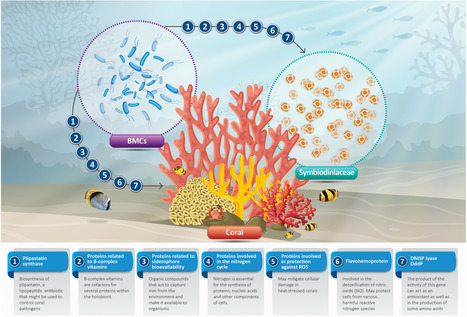



 Your new post is loading...
Your new post is loading...


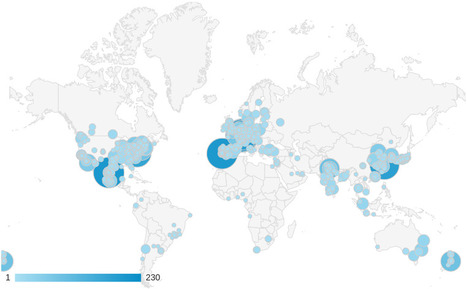
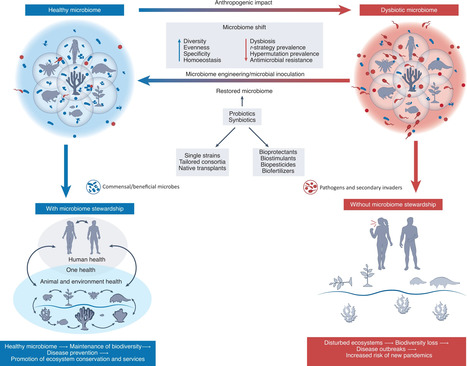

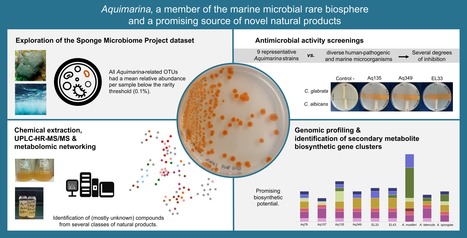
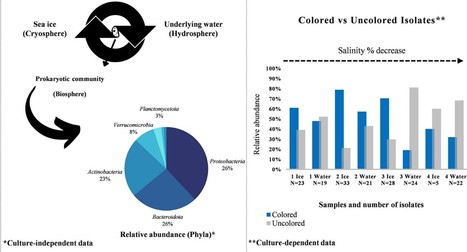
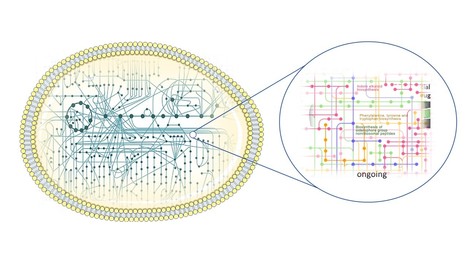
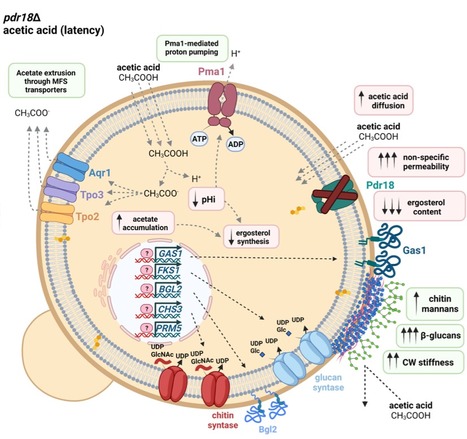
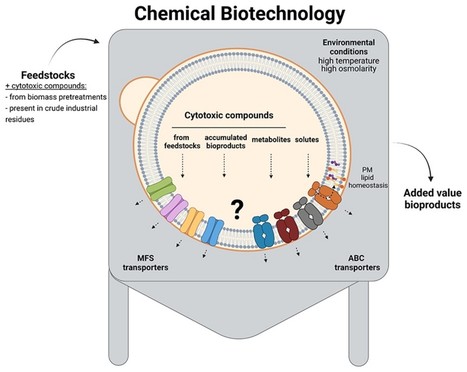
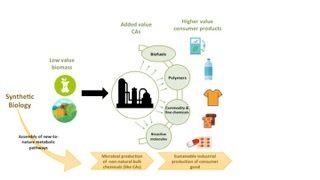

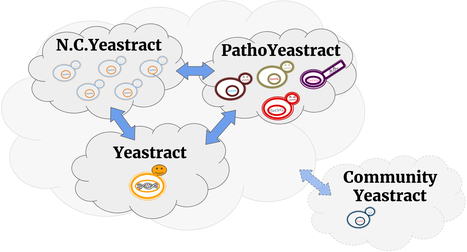
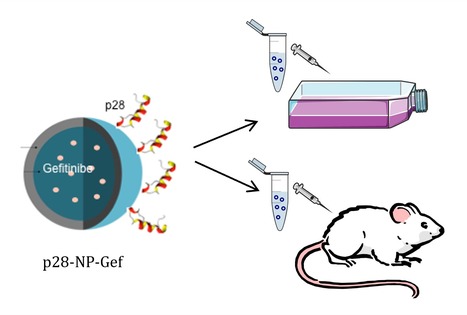

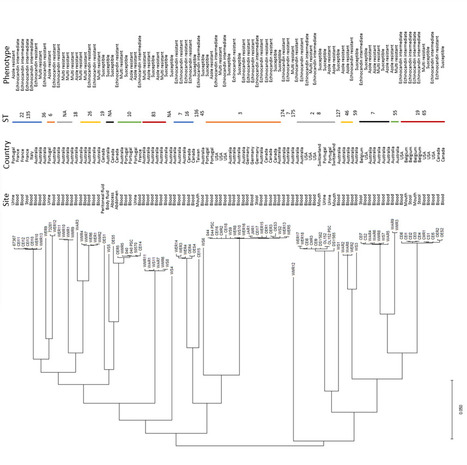
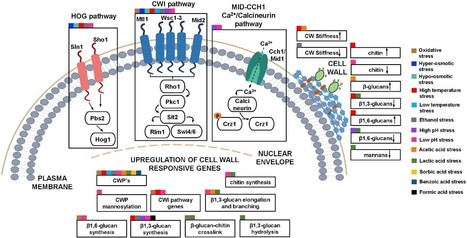
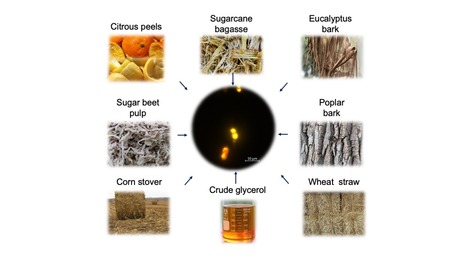

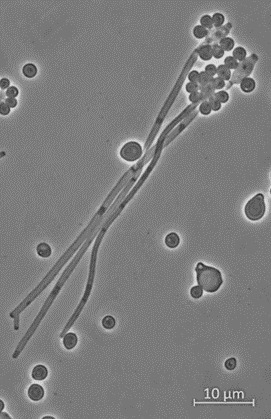
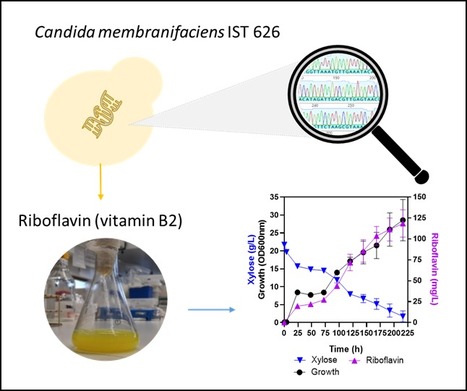
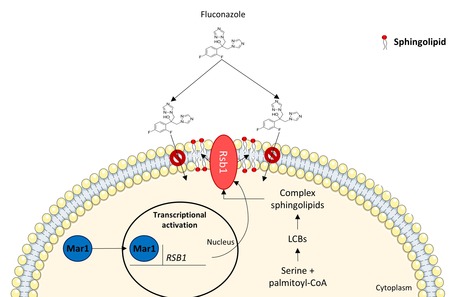
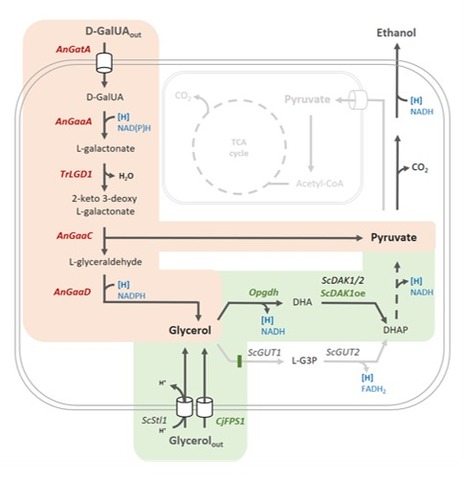


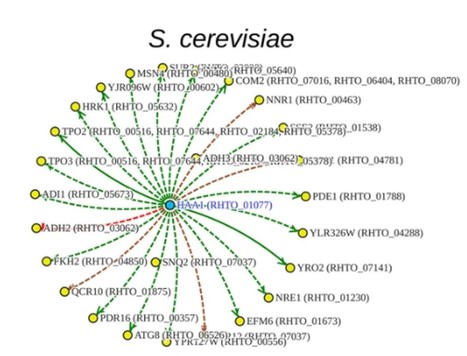





Check full paper here